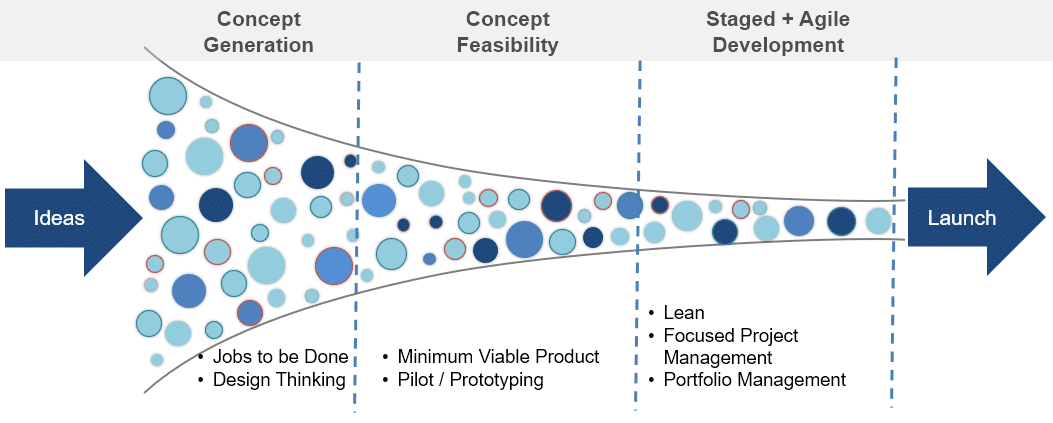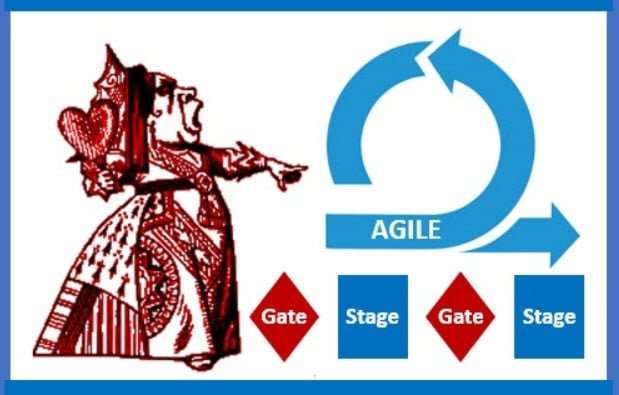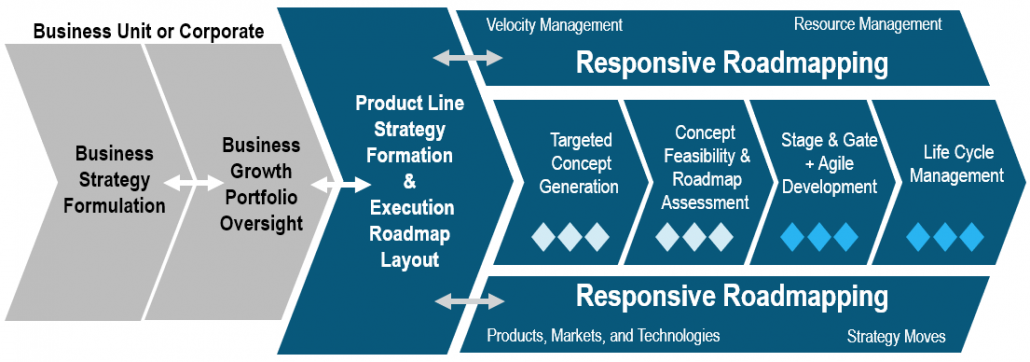![]()
PROCESS FLOW AND PRODUCT LINE VELOCITY
Product development seems so easy at first glance. You find an idea, and then you develop it into a product or service. What could be so hard? Yet every manager knows this view is naive. Let’s face it. Product development is difficult.
And doing it repeatedly with big successes is the Holy Grail of business. It’s a license to print money!
Repeating Your Magic
Companies face two monumental challenges in creating their own money printing machine. The first is to conjure up one terrific idea after another. And the second challenge is equally tricky. It’s to transform each concept into a successful product. Then, once you do this, you must do it again and again.
Today, many companies are changing how they tackle their money printing challenge. They’re moving from a single-product to a multi-product approach. It’s a major change that’s driving major gains.
The old school approach to product development has been to “divide and conquer” while pushing projects through a funnel. Marketers find many ideas then filter out the “poor” ones. Next, senior managers screen the good concepts further and decide which should move forward to development. Then engineers trial different product variants to see what’s possible. And marketers will test what the market will allow and what customers will buy.
Old School Product Development Process
Focused on creating, screening, and speeding the development of individual products.
Old School Advances
Yes, the old school approach has made many advancements. Smart managers added Jobs-to-be-Done and design thinking to the front-end. They also added Lean, Agile, and MVPs. Plus, they honed project management and portfolio prioritization to speed up stage and gate development practices. And the results are impressive. Even with growing regulations and requirements, the old approach is faster and more efficient than fifteen or twenty years ago.
But the old approach pushes one product at a time. And that’s off-track from what companies need.
Even old school portfolio management doesn’t track in the right direction. It stresses discounted cash flows couple to time-to-market measures to prioritize development projects, one against another. The practice gives little attention to how decisions impact a product line. It disregards key concerns like customer satisfaction, competitive positions, and long-term gains. And old school portfolio management seldom includes front-end work or strategy initiatives such as acquisitions and licensing.
Run as fast as you can!
Unfortunately, old school enthusiasts find themselves in a “Red Queen’s Race.” They see competitors enrolled in the same school. And everyone is running as fast as possible to stay in the same place. And it eventually hits home that all competitors have the same approach tied to the same “time-to-market” mantra.
You know the Red Queen’s Race is real when top management keeps calling for radical and disruptive innovations. They’re asking for home runs because the old approach doesn’t produce enough. Leaders will say, “let’s be bold and big,” as they see a technology tsunami approaching and major market shifts taking place. The fear of lost opportunities and shrinking market share can be potent motivators.
Old School product development is like Lewis Carol’s Red Queens Race in Alice in Wonderland. You must run as fast as you can to stay in the same place!
Front-end to Back-end
The new approach is different. It orchestrates work and decisions from business strategy through life cycle management. Plus, managers should purposely design it to maximize a product line’s velocity, not just the speed of one project at a time.
As you dive into the new school approach, recognize the need to focus on a product line, not just several projects running in parallel. It’s because the new school approach focuses on a product line’s flow. It’s also counter-productive for two or more lines to be managed through one process. That’s because the new school approach tailors the process specific to a product line. And it’s near impossible for two or more product lines to have the same characteristics, especially in the same company. Such a standard process would slow down one or more of the product lines.
New School Velocity Oriented Process
Focused on accelerating a product line’s velocity, not speeding the development of one product.
Product Development and Management Process Flow focused on Maximizing a Product Line’s Velocity
Focus on Product Line Velocity
The new approach seeks to maximize a product line’s flow. The goal is to speed up a Product Line’s Velocity.
The velocity is essential. It reflects the line’s movement toward improved competitive positions, better cash flow, and greater customer satisfaction. And it differs from the old-school’s time-to-market mantra.
Please don’t brush off the three velocity orientations. They’re not just motherhood and apple-pie type statements. Each requires much thought. And properly weaving them together across all activities, from the front-end through the back-end, demands deep insights and much strategic thinking.
When you shift your focus from a single project’s time-to-market to a product line’s velocity, you’re changing your process’s underlying purpose and direction. That’s why the new school approach is so different.
Product Line Velocity Focus Versus Single Product Time to Market
The change in focus is a major advance for product development. It changes the workflow, decision flow and information flow from before concept development to in-market product management.
Product Line’s Velocity versus Time-to-Market. The velocity has three orientations: toward greater customer satisfaction, improved cash flow, and stronger competitive positions.
Every process has three streams that weave together like a rope: a workflow, an information and data flow, and a decision flow. You’ll find the new school approach connects front-end to back-end by connecting the streams.
Screening Out Screening
The old approach uses screening and selection to connect the workflows from the front-end to the back-end. It then drives development by seeking faster time-to-market, one project at a time. But the new approach is different. It stresses targeted innovation created purposely to accelerate the line’s flow. And it seeks to streamline the workflow and decision flow, beginning with strategy formation and extending through life-cycle management.
The new approach does encourage radical and disruptive innovations. But it supports only those that speed up the line’s flow. Teams can target such innovations purposely to create and renew platform-levers that affect the line’s performance. And success may even demand the product line to undertake a significant pivot.
Radical & Disruptive Innovations
When major innovations arise that don’t help the line’s velocity, the new approach will ring-fence them away from the line. This is because non-product line innovations may present a far greater value to a business unit than the product line. And the new process is not designed to support them.
If a project is on the product line’s roadmap and progresses through one sub-process, there shouldn’t be a reason to screen the project. Creating a deliberate target places that project on the roadmap. And by doing so, it reduces the wasted time and effort consumed by those projects screened out using the old approach.
Intense Focus on Velocity
The new approach creates an intense focus on improving a product lines’ velocity. And to do so, companies must decrease the importance placed on speeding individual development projects. This change is significant and it’s why the new approach differs so much from the old approach.
Learn more about Product Line Velocity and the Process to Speed it up.
Contact Us to learn how to apply Velocity, Flow, and Systems Thinking to your product line.
Click here to add your own text





